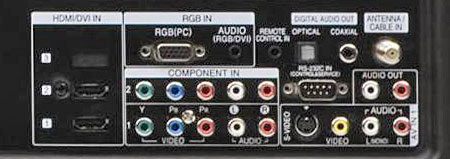LG 50PG60 Plasma TV Setup & Tests
Of course, the first thing I wanted to do was check out the THX mode. Was it really as accurate as it's supposed to be? Not quite. The grayscale was all over the map, and blue was the only color point that hit the mark (see Measurements). When I asked THX about this, I was told that unit-to-unit variations are to be expected, and the company recommends that even the THX mode should be calibrated by a trained technician for best results.

What? I thought the whole idea of a THX mode was to produce an accurate image out of the box. Granted, it wasn't horrible, but it wasn't correct, either. I can certainly understand the concept of sample variations, but I was hoping they wouldn't be so pronounced.
Turning to the 10-point calibration controls in Expert mode, I was able to get the grayscale and color points much closer to where they should be, but I couldn't get them quite as perfect as I could in the 47LG60. For example, the controls behaved somewhat erratically—in some cases, increasing or decreasing a control by a single click resulted in no change, whereas doing so with another control caused the measurement to jump quite a bit.
Interestingly, the sharpness control seemed to do nothing up to a value of 55, above which ringing—white halos around black lines on a gray background—was very evident. Also, the black level measured quite high, which was disappointing.
Perhaps even more disappointing was the 50PG60's propensity for image retention, which was visible after only a few seconds of a static picture such as a test pattern. LG offers several ways to combat this, including an orbiter (moves the image around by a few pixels every so often), inversion (displays a color negative of the image), and white wash (floods the screen with a solid white field). In my experience with the set, image retention faded after some motion video, and I would expect it to become less noticeable after maybe 100 hours of use.
As I mentioned earlier, one of the goals of THX display certification is to assure that the TV's video processor is up to snuff, and for the most part, the 50PG60 passed my processing tests just fine. Starting with the Spears & Munsil test HD DVD at 1080i via HDMI, the set picked up 3:2 pulldown almost immediately, including incoherent edits, but 2:2 never quite locked on.
The HQV Benchmark HD DVD at 1080i revealed that the LG's noise reduction was fairly effective while softening the picture ever so slightly. Jaggies were invisible, and the video and film resolution-loss tests both looked solid as a rock, which is rare in my experience. On the film resolution-loss test, the oscillating resolution pattern looked a bit jerkier than usual, as did the pan across the bleachers. Speaking of the bleacher pan, detail was excellent, but there were faint diagonal moiré lines in the farthest—and thus smallest-looking—seats. This mirrored the same type of artifact I saw in high-frequency test patterns.
Taking a look at the HQV Benchmark DVD at 480i via component, detail was okay but not great. Jaggies were generally mild, though the waving flag was a bit worse than the other tests. Noise reduction was very effective without softening the image more than DVD looks anyway. The set picked up 3:2 pulldown almost immediately, though 2:2 was not great.
Next, I took a look at FPD Benchmark on Blu-ray. All motion-resolution tests were very clear with great detail—no need for 120Hz here! The 0-100 ramp had a bit more banding than I've seen on other sets, and the 0-25 ramp had still more. Differentiation in the mostly black and mostly white shots was excellent.
Finally, I cued up chapter 8 of Mission: Impossible III on HD DVD at 1080i. The pan across the staircase pulsed with some of the worst moiré I've seen. On the plus side, the shadow detail in the catacombs was superb.
- Log in or register to post comments




















































